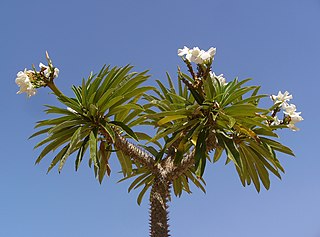
Pachypodium lamerei is a species of flowering plant in the family Apocynaceae. It is a stem succulent, photosynthesizing mainly through its trunk, and comes from the island of Madagascar, off the east coast of Africa. It has large thorns and leaves mostly just at the top of the plant, and large, fragrant flowers. The species has become one of the best known pachypodiums in cultivation, being relatively easy to propagate and grow. In cultivation it is often marketed as the Madagascar palm, despite its not being a palm at all. A variety called "Ramosum" has been described. It is distinguished mostly by a dwarf growth habit and its more rounded corolla lobe.

Chamaecyparis obtusa is a species of cypress native to central Japan in East Asia, and widely cultivated in the temperate northern hemisphere for its high-quality timber and ornamental qualities, with many cultivars commercially available.

Yucca elata is a perennial plant, with common names that include soaptree, soaptree yucca, soapweed, and palmella. It is native to southwestern North America, in the Sonoran Desert and Chihuahuan Desert in the United States, southern Nevada, southwestern Utah, and northern Mexico. Yucca elata is widely distributed, although its population appears to be decreasing.

Quercus pontica, the Pontine oak or Armenian oak, is a species of endangered oak currently extant to the western Caucasus mountains of Georgia and northeastern Turkey where it grows at altitudes of 1,300–2,100 metres.

Beaucarnea recurvata, the elephant's foot or ponytail palm, is a species of flowering plant in the family Asparagaceae. The species was native to numerous states of eastern Mexico but is now confined to the state of Veracruz. Despite its common name, it is not closely related to the true palms (Arecaceae). It has become popular in Europe and worldwide as an ornamental plant. There are 350-year-old Beaucarneas registered in Mexico.
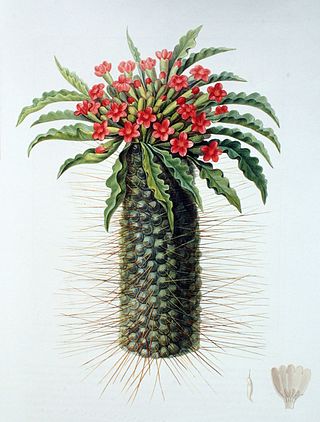
Pachypodium namaquanum, also known as halfmens or elephants trunk, is a succulent plant of Southern Africa. The genus name Pachypodium is from the Greek for 'thick foot', an allusion to its swollen base, while the species name namaquanum is a reference to Namaqualand.
Cyphosperma tanga is a species of flowering plant in the family Arecaceae. It is found only in Fiji. Cutting by the Forestry Department resulted in the serious depletion of one subpopulation in 1970 and also continues to affect another more recently discovered subpopulation. Seed crops of reasonable size appear to be extremely infrequent and it is threatened by habitat loss.

Hyophorbe lagenicaulis, the bottle palm or palmiste gargoulette, is a species of flowering plant in the family Arecaceae. It is native to Round Island, Mauritius.

Aloidendron pillansii, formerly Aloe pillansii, the giant quiver tree or bastard quiver tree, is a large, branching species of succulent plant indigenous to southern Africa. It is regarded as critically endangered.
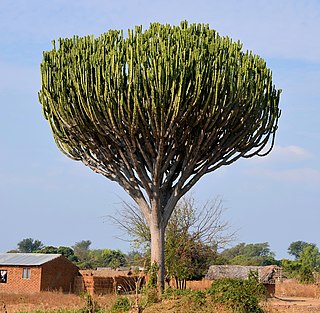
Euphorbia ingens is a species of flowering plant in the family Euphorbiaceae. It is native to dry areas of southern Africa. It is popularly known as the candelabra tree or naboom. Its milky latex can be extremely poisonous and is a dangerous irritant.

Calibanus was a genus of two species of flowering plants, both evergreen succulents from dry areas of northeastern Mexico.The genus was subsumed in the genus Beaucarnea in the year 2014. The APG III classification system places Beaucarnea in the family Asparagaceae, subfamily Nolinoideae The now-defunct Calibanus was formerly included in the Agavaceae but was separated from them, for it is polycarpic and dioecious. Its name refers to the monster Caliban, an antagonist in Shakespeare's The Tempest.

Aloiampelos gracilis, formerly Aloe gracilis, the rocket aloe, is a succulent plant, endemic to dry thicket vegetation around the city of Port Elizabeth, South Africa. Its natural range lies just to the west of the related Aloiampelos ciliaris, and it occurs in bushy fynbos and dry thickets, and clustered on rocky outcrops at all altitudes. Its range extends westwards into the Baviaanskloof mountains.
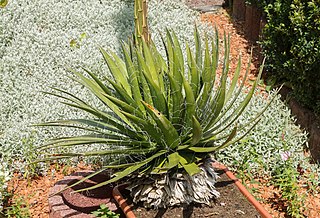
Agave filifera, the thread agave, is a species of flowering plant in the family Asparagaceae, native to Central Mexico from Querétaro to Mexico State. It is a small or medium-sized succulent plant that forms stemless rosette up to 3 feet (91 cm) across and up to 2 feet (61 cm) tall. The leaves are dark green to a bronzish-green in color and have very ornamental white bud imprints. The flower stalk is up to 11.5 feet (3.5 m) tall and is densely loaded with yellowish-green to dark purple flowers up to 2 inches (5.1 cm) long. Flowers appear in autumn and winter.
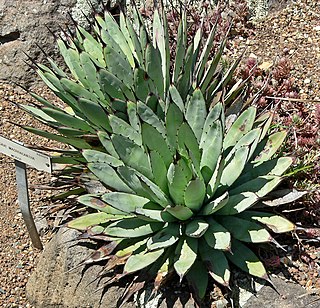
Agave macroacantha, the black-spined agave or large-thorned agave, is a species of succulent flowering plant in the family Asparagaceae naturally occurring in Oaxaca and also near the town of Tehuacan in the State of Puebla, Mexico.

One of only two species in its genus, Calibanus hookeri is a member of the family Asparagaceae native to Tamaulipas in Mexico, which can easily be mistaken in the wild for a boulder overgrown with grass tufts.
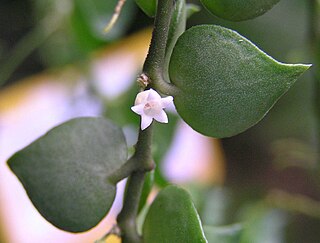
Dischidia ruscifolia, also known as million hearts, is an epiphytic plant native to the Philippines.

Beaucarnea hiriartiae is a plant in the family Asparagaceae, native to Mexico. The species is named for the botanist Patricia Hiriart Valencia.
Beaucarnea olsonii is a plant in the family Asparagaceae, native to Mexico. The species is named for the botanist Mark E. Olson.
Beaucarnea sanctomariana is a tree in the family Asparagaceae, native to Mexico. The species is named for the town of Santa María Chimalapa in Oaxaca.
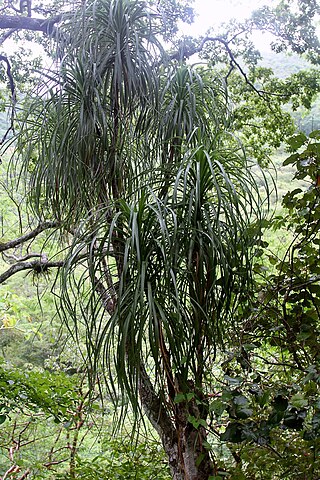
Beaucarnea goldmanii is a tree in the family Asparagaceae. It is native to Mexico and northern Central America.

















